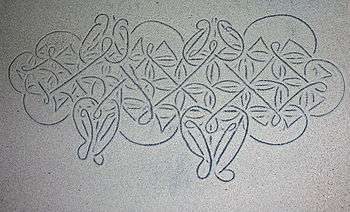Sand drawing

Sand drawing (or sandroing in Bislama)[1][2] is a ni-Vanuatu artistic and ritual tradition and practice, recognised by UNESCO as a Masterpiece of the Oral and Intangible Heritage of Humanity.[3][4]
History
The Vanuatu Cultural Centre has noted that the spirit of sand drawing tends to disappear, only a few practitioners still master the special techniques of sand drawing. Nowadays, this form of art is mainly used as a graphic layout for advertising or tourism ends, and its original sense and purpose is getting lost. A National Action Plan for the Safeguarding of Sand Drawing has been initiated by the Centre, together with the Save Sand Drawings Action Committee; the programme is sponsored by UNESCO. The project notably led to a National Sand Drawing Festival, as from 2004.[4]
Description
Sand drawing is produced in sand, volcanic ash or clay. It consists of "a continuous meandering line on an imagined grid to produce a graceful, often symmetrical, composition of geometric patterns". The artist's implement is a single finger.[3]
UNESCO describes sand drawing as:
A rich and dynamic graphic tradition [which] has developed as a means of communication among the members of some 80 different language groups inhabiting the central and northern islands of Vanuatu. The drawings also function as mnemonic devices to record and transmit rituals, mythological lore and a wealth of oral information about local histories, cosmologies, kinship systems, song cycles, farming techniques, architectural and craft design, and choreographic patterns. Most sand drawings possess several functions and layers of meaning: they can be “read” as artistic works, repositories of information, illustration for stories, signatures, or simply messages and objects of contemplation.[3]
The Turaga indigenous movement based on Pentecost Island write using Avoiuli, an alphabet inspired by designs found in traditional sand drawings.
Since the traditional art of sand drawing is so precisely geometrical, academic research is being led to associate the (ethno-) mathematical patterns held in this art, and correlate it with modern mathematics to get a sense of the potential scientific knowledge carried by the builders of the civilizations practicing it.[5] The ancient Greek mathematician studying geometry by drawing figures in the sand also leads to the idea that traditional Sandroings convey much more than a pleasing visual effect.[6]
Artists
Non-traditional sand drawing
- Jim Denevan, American chef and artist from the surf culture, creates large scale sand drawing on California beaches during low tides.[7]
See also
- Sandpainting
- Kolam – Tamil sandpainting
References
- ↑ "Sandroing", Vanuatu Cultural Centre
- ↑ Australian Broadcasting Corporation – Lingua France – Vanuatu Sand Drawing
- 1 2 3 "Proclamation 2003: 'Vanuatu Sand Drawings'", UNESCO
- 1 2 "The National Action Plan for the Safeguarding of Sand Drawing" Archived 2006-04-23 at the Wayback Machine., Vanuatu Cultural Centre
- ↑ Eric Vandendriessche (2014). "String Figures and Sand Drawings from Vanuatu: A Comparative Study of Mathematical Practices". Mpiwg-berlin.mpg.de. Retrieved 13 October 2018.
- ↑ Peter Prevos (2 January 2018). "Sand Drawings from Vanuatu: Four Layers of Meaning in Sandroings". Horizonofreason.com. Retrieved 13 October 2018.
- ↑ "Amazing Sand Drawings on California Beaches". Boredpanda.com. Retrieved 13 October 2018.
